Tucked-away corners of your yard hold more potential than you might expect—especially when thoughtfully styled to feel secluded, magical, and refreshingly different from traditional garden layouts. Whether you’re working with a compact patio or a spacious backyard, small design tweaks can convert underused space into a lush, personal hideaway. From layered greenery to curated seating nooks, this kind of retreat doesn’t require extravagant landscaping—just intentional detail. With outdoor living trends continuing to surge, these curated ideas offer practical, stylish ways to make any outdoor area feel transportive. Keep reading to uncover effortlessly charming concepts that deliver high-impact serenity with everyday accessibility.
Hidden Entrance with Overgrown Archway

Tucked between hedges and framed by unruly foliage, this type of garden entrance offers both privacy and intrigue. Ivy, jasmine, or clematis can be trained to drape over an existing arbor or arch, softening the structure with organic elegance. As plants mature, the once-visible entrance gradually disappears, giving way to a living portal that leads visitors into a tranquil escape. The secret lies in purposeful neglect—allowing nature to do the cloaking. Gravel or brick edging beneath the archway adds a subtle path marker while maintaining the illusion of discovery. When paired with dense shrubbery or tall ornamental grasses, the area surrounding the archway remains visually secluded, further enhancing the secretive ambiance. This garden concept works exceptionally well for small backyards or narrow side yards where space is limited but intimacy is essential. Regular trimming is necessary only to maintain passage—not to define it. Lighting is best kept soft and low to preserve the mystique during evening strolls. The charm of this feature lies in its unpredictability—it doesn’t declare itself, it quietly invites. Those who pass through the overgrown archway step into a different rhythm, where time feels suspended, and nature becomes the silent gatekeeper of personal retreat.
Winding Stone Path Leading to a Secluded Nook
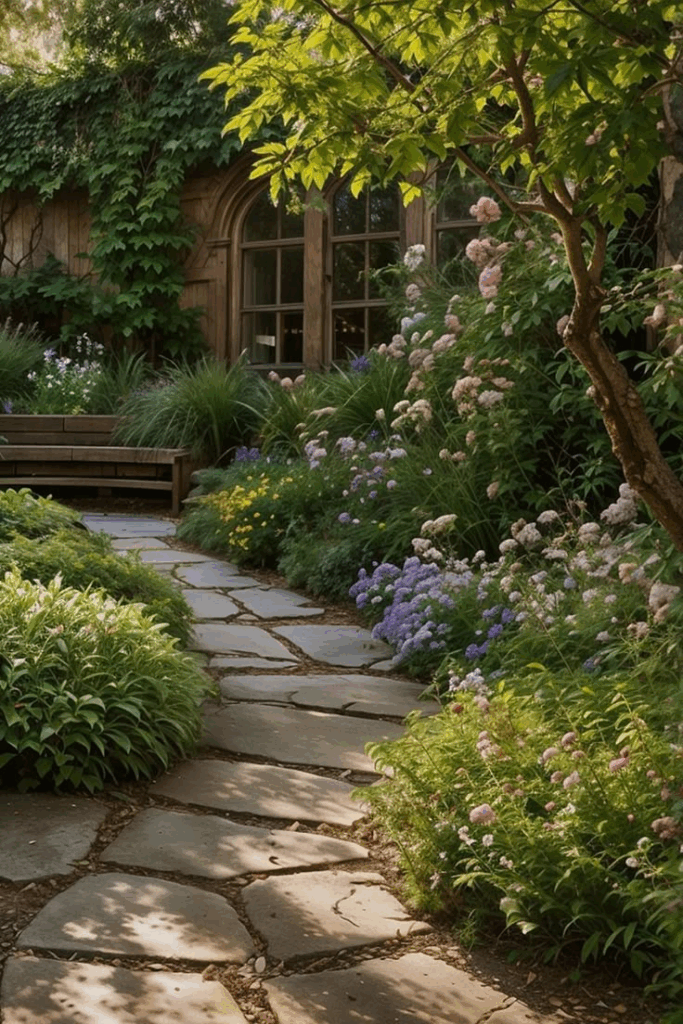
Curved pathways have long held the power to pique curiosity, and in secret gardens, they’re essential to storytelling. Rather than revealing every destination at once, a winding stone path conceals what lies ahead, encouraging slower steps and thoughtful exploration. Varied stone sizes and subtle elevation shifts can enhance the natural look, while moss and creeping thyme between the cracks soften hard edges. The path should weave organically through tall plants—lavender, foxglove, or ferns are ideal—drawing attention away from the route itself and toward the surrounding textures. Ending in a quiet sitting area, birdbath, or tucked-away bench, the journey becomes as memorable as the destination. Strategically placing planters or large rocks along curves helps define the visual rhythm without making the layout feel rigid. This layout works beautifully in both expansive and compact spaces, particularly in areas with dappled sunlight or dense foliage. Consider shaded lighting or lanterns for added charm during twilight. The secluded nook at the path’s end serves as a personal sanctuary, ideal for journaling, reading, or quiet reflection. Unlike straight paths, winding stone layouts add depth, curiosity, and character—qualities that define an unforgettable secret garden experience.
Vintage Iron Gate Covered in Climbing Roses

Faded metal paired with blooming roses captures a rare kind of beauty—one where nostalgia meets nature’s resilience. A vintage iron gate, rust-kissed and aged by time, becomes an enchanting focal point when framed by climbing roses. Varieties like Eden, New Dawn, or Cecile Brunner are ideal for this look, with their cascading blooms and romantic fragrance. The gate doesn’t need to lead anywhere grand; its very presence becomes symbolic—inviting visitors into a world of quiet solitude. Installing it along a boundary wall or between hedgerows adds to the illusion of separation from the outer world. Over time, the roses weave themselves through every bar and curve of the gate, softening the iron’s sharp geometry. The contrast between wrought iron and delicate petals creates a dramatic visual statement without overwhelming the senses. Gravel or stepping stones leading up to the gate can further romanticize the setting. Even when closed, this feature sparks wonder. The placement doesn’t need to be central—it’s often more impactful when discovered accidentally along a stroll. Functional or not, a rose-covered vintage gate transforms any garden edge into a photogenic, aromatic threshold that whispers stories from another era, making it unforgettable for those who pass by.
Sunken Garden with Surrounding Hedges
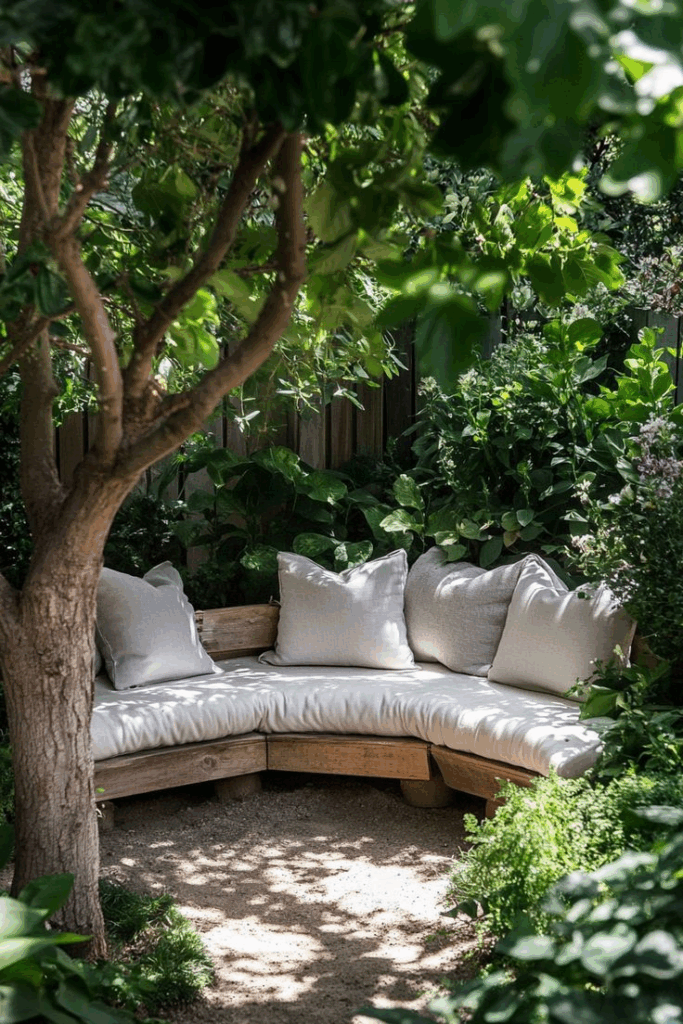
Depth plays a powerful role in creating atmosphere, and a sunken garden enclosed by hedges delivers a sense of both enclosure and serenity. By lowering the central area slightly below the rest of the garden, visual interest increases while sound becomes more muffled, enhancing the feeling of isolation. Boxwood, privet, or yew hedges form excellent vertical walls, their dense foliage blocking wind and noise from the outside. The lowered space can be filled with perennial borders, potted topiaries, or even a small bistro table for intimate gatherings. This layout works particularly well in sloped yards or unused corners of larger plots. Drainage is crucial—install gravel beneath the soil to avoid waterlogging in rainy seasons. The surrounding hedges also offer structure during colder months when flowering plants go dormant. Tall urns, antique statues, or columnar evergreens can be placed symmetrically for balance. Because it’s visually hidden until one steps down, a sunken garden provides an unexpected transition from open space to tranquil retreat. Whether used for morning tea or evening meditation, the enclosed design of this feature offers both visual elegance and functional privacy, making it one of the most enduring secret garden elements.
Mirror Panels to Create Illusion of Depth

Mirrors are rarely associated with outdoor gardens, yet when used tastefully, they add magical dimension to tight spaces. Installing mirror panels behind plants or within fences helps reflect surrounding greenery, giving the illusion of a larger, deeper garden. This trick is especially effective in small urban yards or balcony gardens where space feels restrictive. Mirrors should be weatherproof and subtly framed—wood or wrought iron works well for a rustic aesthetic. Strategic placement is key: avoid reflecting blank walls or harsh sunlight, which can cause glare. Instead, position mirrors behind climbing plants or hanging planters to mimic continued growth. When partially obscured by foliage, the reflected space appears to extend naturally beyond physical boundaries. In dimmer corners, mirrors can also bounce ambient light, brightening shaded areas and drawing the eye inward. Vertical panels work best to create the illusion of depth, while broken or antique-finished glass adds character without overwhelming the scenery. For safety, always use garden-safe materials or acrylic alternatives. Over time, weathering on the surface will lend an authentic, worn-in feel. This subtle visual trick adds a surreal yet charming layer to any secret garden—blurring the line between reality and illusion with quiet brilliance.
Canopy of Hanging Fairy Lights
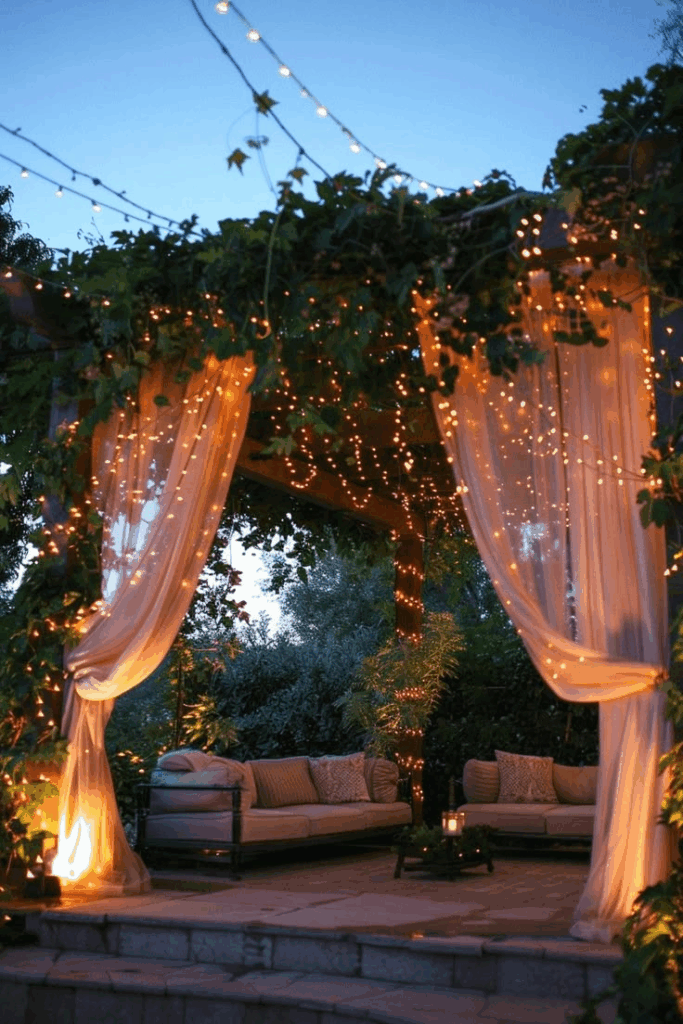
Evening gardens have a language of their own, and fairy lights suspended from trees or pergolas bring that language to life. A canopy of warm-toned LED string lights casts a soft ambient glow, ideal for twilight reading, tea-time conversations, or nighttime solitude. Suspend the strands across tree branches, garden arches, or custom-built posts to form an overhead web of light. Battery-operated or solar-powered options reduce wiring hassles and offer flexibility in placement. To maintain an organic look, drape the lights unevenly and allow a few strands to hang lower for charm. Pairing lights with climbing plants—like wisteria or honeysuckle—makes the setup feel naturally integrated rather than staged. This idea works especially well in corners where other lighting may not reach or around seating areas meant for relaxation. Choose bulbs with a golden hue over stark white for a cozier atmosphere. For safety and durability, weatherproof your setup and check regularly for damage. The glow should feel gentle, never glaring, encouraging visitors to linger longer. Whether viewed from inside the home or experienced up close, a canopy of fairy lights turns any garden space into a quiet dreamscape, where each flicker carries a whisper of calm.
Antique Bench Surrounded by Wildflowers
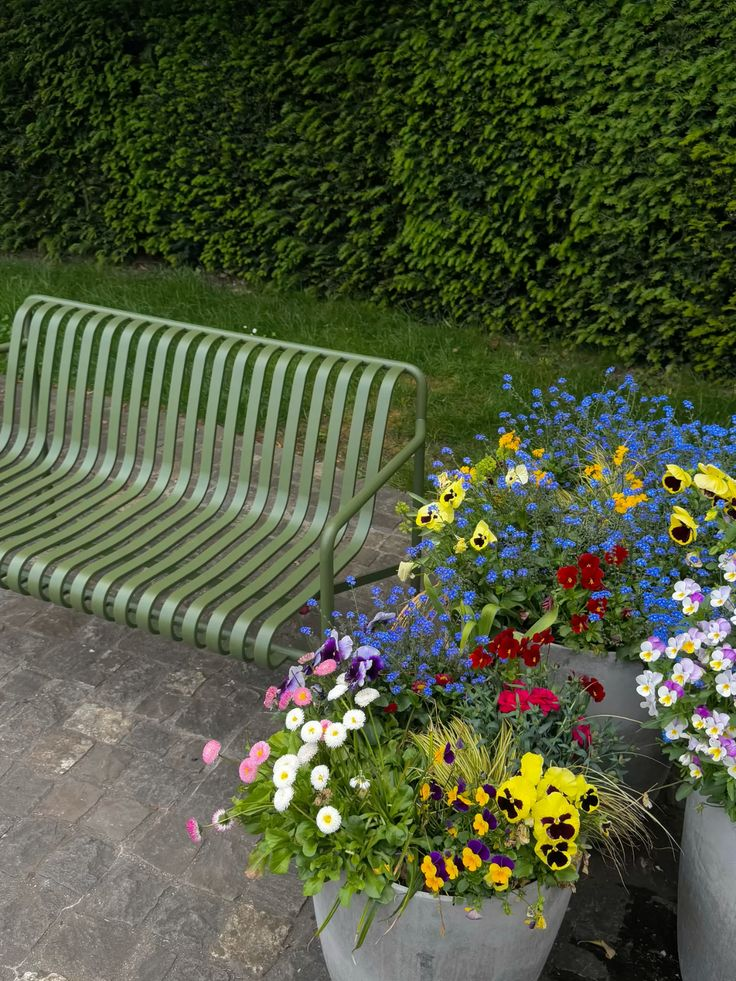
Few features invite quiet reflection like a weathered bench surrounded by gently swaying blooms. Selecting an aged wooden or wrought iron bench with patina adds authenticity without needing dramatic embellishments. Nestle it within a natural planting scheme that includes black-eyed Susans, cosmos, coneflowers, and Queen Anne’s lace for a wild, effortless charm. These self-seeding blooms ensure seasonal renewal with minimal maintenance. Allow grass paths or narrow stepping stones to lead into the space, but keep the bench itself partially obscured for a tucked-away look. Placement beneath partial shade—such as beside a fruit tree or flowering shrub—ensures comfort through all seasons. Small touches like a trailing vine growing through the bench back or a few moss patches on the legs only enhance its storybook quality. This setup feels personal and nostalgic, ideal for slow mornings, sketching sessions, or sunset daydreams. It also offers visual softness in contrast to formal garden elements. Surrounding the area with pollinator-friendly plants not only adds life but attracts butterflies and bees, further enriching the sensory experience. An antique bench amidst wildflowers serves as a poetic focal point—a moment of stillness in an ever-changing green landscape.
Secret Water Feature Behind Lush Foliage

Subtle water sounds can instantly transform a garden’s mood, and placing a concealed feature behind dense greenery creates a moment of surprise. Think beyond grand fountains—small trickling urns, bubbling rocks, or shallow pools work just as well. The goal is auditory first, visual second. Nestle the water element behind thick plantings like hostas, ferns, and large-leafed caladiums to let the discovery unfold naturally as one moves through the space. The ambient sound not only soothes but also helps mask nearby street noise or neighboring chatter. Adding moss around the base reinforces a woodland feel, while low lighting can accent the shimmer without drawing too much attention. For gardens with limited space, wall-mounted spouts into stone basins offer compact yet captivating options. Maintenance should be minimal—keep the pump clean and check water levels regularly. Surrounding the feature with flowering vines or scented plants like gardenia can further intensify the sensory layering. This quiet design choice rewards slow exploration and offers visitors an immersive pause. Rather than demanding attention, a hidden water feature gently captures it—making it a signature secret garden element that delights the senses and enhances intimacy.
Moss-Covered Statues Peeking Through Plants

Sculptures aged with moss feel like long-lost relics rediscovered among the greenery. When half-hidden behind tall grasses, shrubs, or ivy-covered walls, they whisper stories of forgotten eras. Concrete or stone figures—cherubs, urns, or mythical creatures—age gracefully when placed in damp, shaded areas where moss naturally thrives. Avoid polishing or cleaning; the patina is part of the charm. Allow native groundcovers and creeping plants to weave gently around the base, enhancing the statue’s integration with its surroundings. This approach works particularly well near transitional paths or tucked between hedges where visual surprises can unfold gradually. Avoid overly ornate or shiny statues—rough textures hold moss better and blend into wild environments more seamlessly. You may also encourage moss growth by misting regularly and using buttermilk mixtures on surfaces. When carefully positioned, these figures give the illusion of a garden that predates its caretaker. Over time, they develop a living costume of green, merging art with nature. Rather than acting as focal points, moss-covered statues enrich the garden’s mystery—quiet companions rather than decorations—always slightly obscured and never announcing their presence outright. The effect is contemplative, dreamlike, and wonderfully unexpected.
Hidden Swing Hanging from a Tree Branch
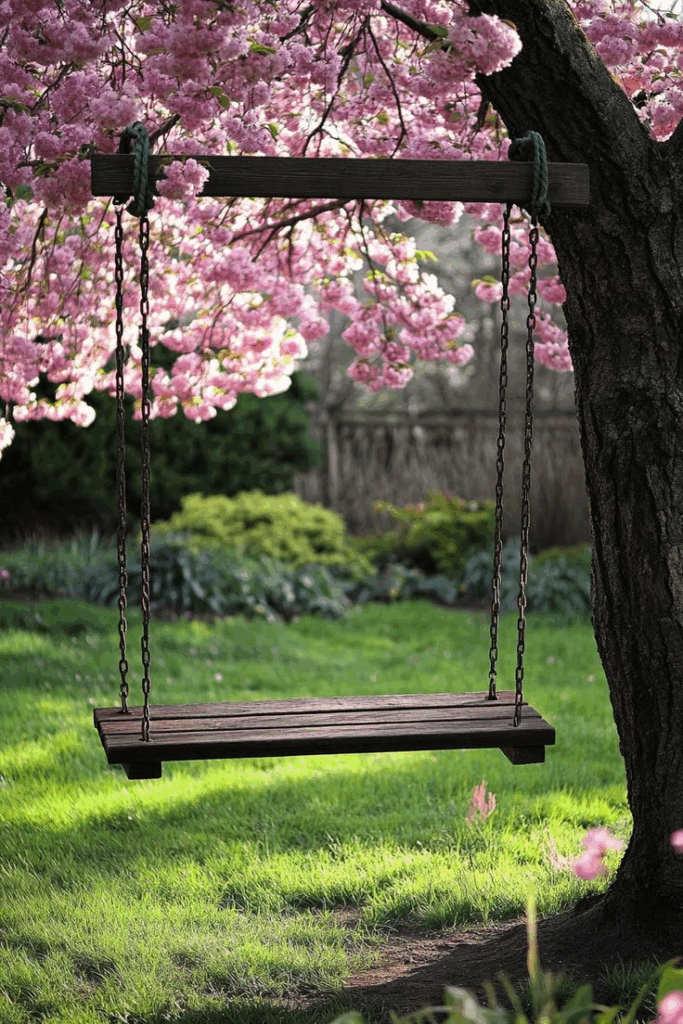
Unexpected movement in a garden can be enchanting, especially when that movement is from a swing gently swaying beneath a canopy of leaves. A simple wooden plank suspended with natural rope becomes a magical element when partially hidden among trailing branches or low-hanging foliage. Opt for a mature tree with strong horizontal limbs—oak, maple, or mulberry provide both shade and structural integrity. Place the swing just off the main path, making it visible only from certain angles to maintain the feeling of discovery. Overhead vines or lanterns can frame the scene without overwhelming it. For added comfort, consider a curved seat or simple cushion in natural fabric. Safety is essential—check the rope and branch health regularly. Children may see it as playful; adults may see it as nostalgic, but all will feel its charm. Surround the area with ground-level greenery and scent-rich plants like lavender or lemon balm for a multi-sensory moment. This element works particularly well in more informal, wooded gardens and offers a physical invitation to pause. The swing doesn’t need to move much—its presence alone makes the space feel alive. It’s not just décor; it’s an emotion waiting to be experienced.
Overgrown Pergola with Blooming Vines
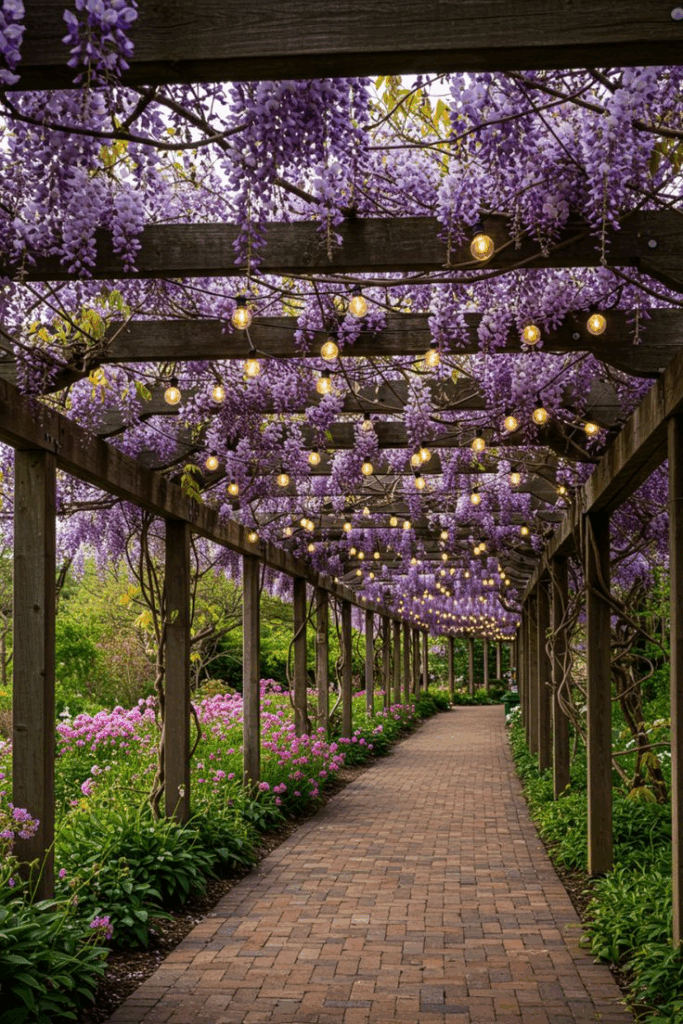
Structural garden elements become infinitely more romantic when time and nature blur their edges. A pergola, left to host climbing plants without strict pruning, takes on an organic architecture that feels both aged and alive. Install a wooden or metal frame at a garden entrance or above a seating area, and allow fast-growing vines like wisteria, clematis, or trumpet vine to take hold. Over time, the lines between man-made and natural blur, creating shade and layered texture that shifts with the seasons. Letting certain branches trail down or twist sideways softens the geometry and welcomes natural imperfections. Place a rustic bench or vintage table beneath for a tucked-away moment that feels sheltered without being enclosed. In late spring or summer, blooming vines bring bursts of color and fragrance, while the structure itself becomes more hidden year after year. Dappled light through foliage above creates a dreamlike play of shadow below, perfect for reading or quiet meals. The overgrown look doesn’t suggest neglect—it reflects patience and trust in nature’s choreography. This feature becomes more than a passage or shelter; it turns into a living, evolving sculpture that deepens the magic of a secret garden.
Stepping Stones Leading to a Hidden Alcove

Visual storytelling begins beneath your feet when stepping stones wind toward a concealed destination. Rather than straight rows, lay stones in slightly irregular patterns, making each turn suggest a new possibility. Gravel or mulch between stones can keep weeds at bay while preserving a natural feel. Ideal for shaded corners, the path should lead away from busy zones and curve softly into denser planting. Endpoints vary—a reading chair, hammock, or birdwatching perch tucked behind taller shrubs or bamboo creates the sense of a secret hideaway. Materials matter—opt for weathered limestone, reclaimed brick, or flagstone with uneven edges to emphasize informality. Surrounding foliage should graze the path’s edge to blur the boundary between walkway and wild. Layering groundcovers like creeping Jenny or moss between stones helps connect each step to the garden’s rhythm. When the final alcove comes into view, it should feel like a reward. By guiding movement slowly and indirectly, stepping stones help the visitor engage with the journey, not just the destination. The result is a simple but emotionally powerful experience—an invitation to wander inward and outward in the same motion.
Enclosed Space with Tall, Dense Shrubs

Privacy often makes the difference between a public garden and a personal retreat. Tall shrubs arranged closely form natural barriers that enclose space without hard boundaries. Evergreens like arborvitae, holly, or laurel offer year-round coverage, while flowering varieties such as viburnum or mock orange add seasonal beauty. Position these plants in overlapping patterns rather than straight lines to keep the enclosure organic. As the shrubs mature, the central area becomes increasingly shielded from external sightlines, inviting introspection or quiet conversation. This setup works particularly well for meditation corners, outdoor yoga zones, or hidden reading spots. Groundcover like liriope or mulch can keep the base tidy while letting the foliage take center stage. For those with limited room, consider fast-growing vertical shrubs planted in staggered rows for maximum effect. Avoid cutting the tops too evenly—varying heights mimic natural woodland edges. A few tall planters or climbing trellises can fill any height gaps. The key is creating an immersive cocoon, not a rigid border. Whether located near a house or deep within the yard, an enclosed garden space framed by shrubs fosters the quiet solitude that defines a secret garden—where the world narrows, and the senses expand.
Rustic Wooden Door Set into a Garden Wall
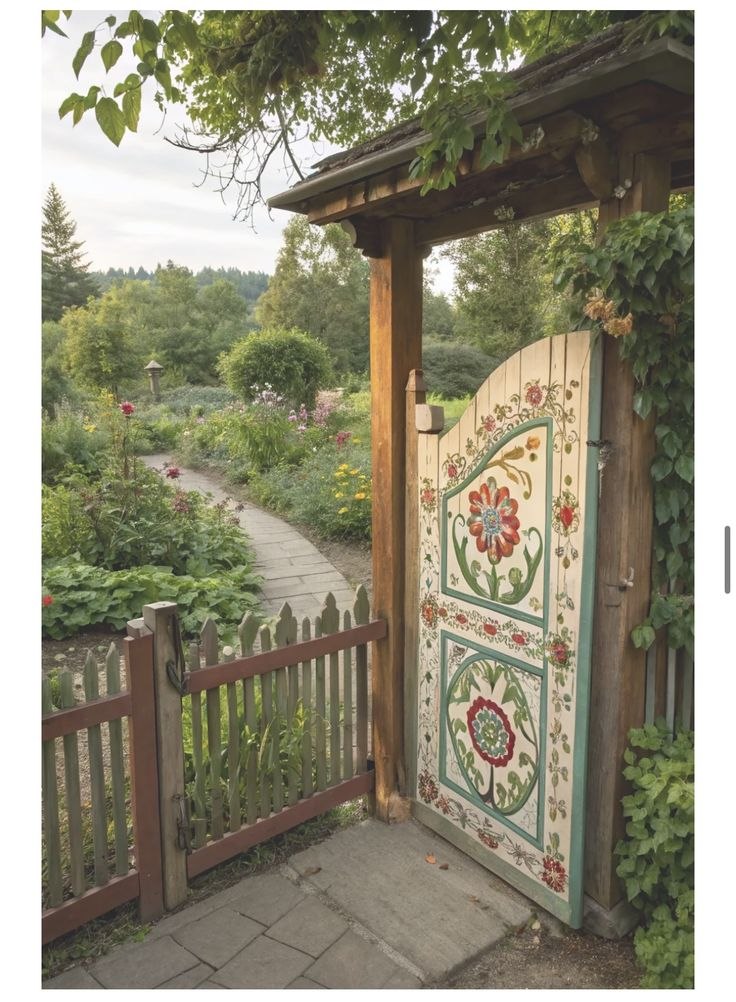
Unexpected entrances hold undeniable charm, and placing a weathered wooden door into a hedge or garden wall adds a strong narrative element. This feature implies that there’s something worth entering, even before one knows what lies beyond. Salvaged doors with peeling paint, antique handles, or iron hinges bring authenticity to the design. Set it into a vine-draped brick or stucco wall for full effect—or even use freestanding trellis panels and plantings to fake the presence of a wall. What makes the door magical is that it doesn’t need to open; it simply needs to exist. If functional, allow it to open into a narrow passage or enclosed seating space. Surround the area with overhanging ivy, foxglove, and old stonework for a storybook ambiance. Accent lighting above or below the frame can subtly draw the eye without spoiling the mystery. The door stands as a symbol—a promise of retreat and imagination, turning even the smallest backyard into a place with hidden corners and whispered stories. When paired with climbing plants and rough textures, it becomes an emotional anchor in the garden’s design.
Camouflaged Garden Shed with Green Roof

Utility doesn’t have to stand apart from beauty. A garden shed disguised with natural textures and a green roof becomes part of the scenery rather than a break in it. Start by choosing weathered wood or stone-like cladding that blends into the landscape. Cover the roof with drought-resistant sedums, succulents, or wildflower turf for visual softness and ecological benefit. Not only does this help regulate interior temperature, but it also provides habitat for pollinators. Paint the door in muted, earthy tones or leave it unpainted to allow natural aging. Surround the shed with tall perennials, ornamental grasses, and climbing vines to obscure its edges further. Paths leading to the structure should feel informal—perhaps even partially overgrown. Inside, the space can serve as a potting bench, reading nook, or storage hideaway. Keep windows small or use old panes for character. This camouflaged structure blends usefulness with aesthetic continuity, proving that even the most practical garden elements can contribute to a hidden, enchanted atmosphere. It doesn’t demand attention—it earns it through harmony with the surroundings.
